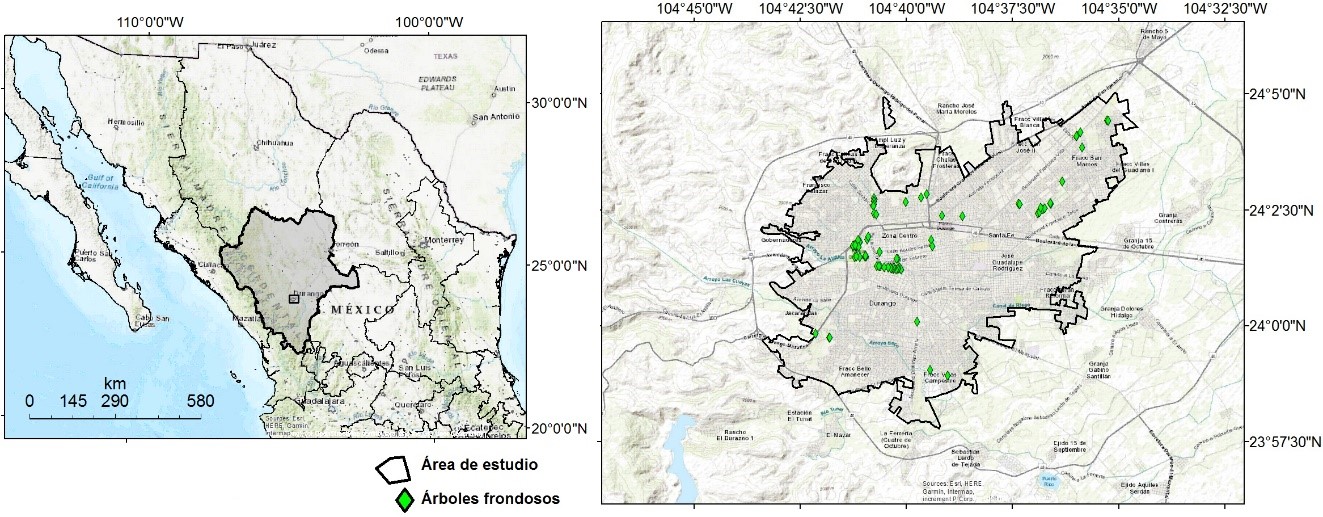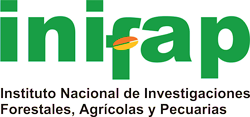Old leafy trees in the provision of ecosystem services in urban areas
DOI:
https://doi.org/10.29298/rmcf.v15i81.1428Keywords:
Green Areas, i-Tree Eco, Urban Planning, Economic Value, Social ValuationAbstract
Mature, leafy trees are characterized by their large size and longevity. They provide many ecosystem services and sometimes are part of the cultural and historical heritage of cities. The objective of this research was to analyze the economic, social, and ecological value of mature, leafy trees in the city of Durango, Mexico. Through satellite images and field inventories, 83 trees were identified with the characteristics of size and longevity. Diameter at breast height, height, diameter and crown condition were measured, as well as temperature and solar radiation. A survey was administered to residents and park visitors to learn about their perceptions of the importance of these trees. The inventory data were analyzed in the i-Tree Eco v6 platform to determine the quantity and economic value of the ecosystem services. Mature, leafy trees in this city store about 1.3 CO2 tons per year, intercept 375 kg of particles smaller than 10 µm, and their substitution value was estimated at MXN $23.6 million. From data taken under and outside the canopy, a difference between 400 and 1 200 Wm2 of intercepted solar radiation and between 6 and 20 °C of temperature was calculated. Derived from the factor analysis, the questionnaires revealed three latent variables, in this order: "disservices", "benefits" and "existential values". No significant differences in the factor scores were found among these variables. This information will allow city managers to define plans for the management and conservation of these type of trees.
Downloads
References
Anderson, N. T. and G. B. Marchisio. 2012. WorldView-2 and the evolution of the DigitalGlobe remote sensing satellite constellation: Introductory paper for the special session on WorldView-2. In: Society of Photo-Optical Instrumentation Engineers (SPIE) (Comp.). Algorithms and Technologies for Multispectral, Hyperspectral, and Ultraspectral Imagery XVIII. SPIE. Baltimore, MD, United States of America. pp. 8093-8100. DOI: https://doi.org/10.1117/12.919756
Arango S., J. F., C. J. Pacheco F. y L. A. Vargas M. 2023. Valoración económica de los servicios ecosistémicos: una revisión sistemática. Revista Venezolana de Gerencia 28(103):948-964. Doi: 10.52080/rvgluz.28.103.3. DOI: https://doi.org/10.52080/rvgluz.28.103.3
Benegas N., L., A. Rojas, A. Iraheta y J. Cárdenas. 2021. Análisis del componente arbóreo y su contribución a los servicios ecosistémicos en la ciudad de Turrialba, Costa Rica. Ecosistemas 30(2):2083. Doi: 10.7818/ECOS.2083. DOI: https://doi.org/10.7818/ECOS.2083
Blancarte-Siqueiros, R. H., G. Perez-Verdin and A. Cortes-Ortíz. 2020. The relationship between quality of life, sense of belonging, and green spaces in urban environments in the city of Durango, Mexico. Revista Chapingo Serie Ciencias Forestales y del Ambiente 26(1):97-111. Doi: 10.5154/r.rchscfa.2019.03.023. DOI: https://doi.org/10.5154/r.rchscfa.2019.03.023
Borelli, S., M. Conigliaro y F. Pineda. 2018. Los bosques urbanos en el contexto global. Unasylva: Revista Internacional de Silvicultura e Industrias Forestales 69(250):3-10. https://dialnet.unirioja.es/servlet/articulo?codigo=7455599. (30 de julio de 2023).
Comisión Nacional del Agua (Conagua). 2014. Programa de medidas preventivas y de mitigación de la sequía 2014 para la ciudad de: Victoria de Durango, Durango. Conagua. Victoria de Durango, Dgo., México. 91 p. https://www.gob.mx/cms/uploads/attachment/file/99854/PMPMS_Victoria_de_Durango_Dgo.pdf. (20 de agosto de 2023).
de la Concha, H., L. Roche C. y A. García B. 2017. Inventario del arbolado urbano de la Ciudad de Mérida. Ayuntamiento de Mérida 2018-2021. Mérida, Yuc., México. 57 p. http://www.merida.gob.mx/sustentable/contenidos/doc/inventario_arbolado_merida.pdf. (15 de junio de 2020).
Granados-Espíndola, J., J. G. Gutiérrez-Cedillo y L. M. Espinoza-Rodríguez. 2022. Calidad visual del paisaje y servicios ecosistémicos en áreas verdes urbanas. Una visión sistémica. Quivera 24(2):111-131. Doi: 10.36677/qret.v24i2.19334. DOI: https://doi.org/10.36677/qret.v24i2.19334
Instituto Nacional de Estadística y Geografía (Inegi). 2021. Panorama sociodemográfico de Durango 2020: Censo de Población y Vivienda 2020. Inegi. Aguascalientes, Ags., México. 99 p. https://www.inegi.org.mx/contenidos/productos/prod_serv/contenidos/espanol/bvinegi/productos/nueva_estruc/702825197834.pdf. (28 de agosto de 2023).
Jim, C. Y. 2018. Protección de árboles patrimoniales en entornos urbanos y periurbanos. Unasylva: Revista Internacional de Silvicultura e Industrias Forestales 69(250):66-74. https://dialnet.unirioja.es/servlet/articulo?codigo=7455607. (30 de julio de 2023).
Leal E., C. E., N. Leal E., E. Alanís R., M. Á. Pequeño L., A. Mora-Olivo y E. Buendia R. 2018. Estructura, composición y diversidad del arbolado urbano de Linares, Nuevo León. Revista Mexicana de Ciencias Forestales 9(48):252-270. Doi: 10.29298/rmcf.v8i48.129. DOI: https://doi.org/10.29298/rmcf.v8i48.129
Martínez-Trinidad, T., P. Hernández L., S. F. López-López y L. Mohedano C. 2021. Diversidad, estructura y servicios ecosistémicos del arbolado en cuatro parques de Texcoco mediante i-Tree Eco. Revista Mexicana de Ciencias Forestales 12(67):202-230. Doi: 10.29298/rmcf.v12i67.880. DOI: https://doi.org/10.29298/rmcf.v12i67.880
Matas, A. 2018. Diseño del formato de escalas tipo Likert: un estado de la cuestión. REDIE Revista Electrónica de Investigación Educativa 20(1):38-47. Doi: 10.24320/redie.2018.20.1.1347. DOI: https://doi.org/10.24320/redie.2018.20.1.1347
Mejorado V., N. A., J. L. Romo L., A. Villanueva M. y A. M. Borja de la R. 2020. Evaluación de la monumentalidad de árboles urbanos en México. Revista Mexicana de Ciencias Forestales 11(60):4-25. Doi: 10.29298/rmcf.v11i60.719. DOI: https://doi.org/10.29298/rmcf.v11i60.719
Méndez M., C. y M. A. Rondón S. 2012. Introducción al análisis factorial exploratorio. Revista Colombiana de Psiquiatría 41(1):197-207. Doi: 10.1016/S0034-7450(14)60077-9. DOI: https://doi.org/10.1016/S0034-7450(14)60077-9
Muraoka, H., N. Saigusa, K. N. Nasahara, H. Noda, … and H. Koizumi. 2010. Effects of seasonal and interannual variations in leaf photosynthesis and canopy leaf area index on gross primary production of a cool-temperate deciduous broadleaf forest in Takayama, Japan. Journal of Plant Research 123:563-576. Doi: 10.1007/s10265-009-0270-4. DOI: https://doi.org/10.1007/s10265-009-0270-4
Nelson, S. A. C. and S. Khorram. 2018. Image processing and data analysis with ERDAS IMAGINE®. CRC Press. Boca Raton, FL, United States of America. 350 p. DOI: https://doi.org/10.1201/b21969
Nowak, D. J. 2021. Understanding i-Tree: 2021 Summary of programs and methods. United States Department of Agriculture, Forest Service, Northern Research Station. Madison, WI, United States of America. 100 p.
Piccolo, J. J. 2017. Intrinsic values in nature: Objective good or simply half of an unhelpful dichotomy? Journal for Nature Conservation 37:8-11. Doi: 10.1016/j.jnc.2017.02.007. DOI: https://doi.org/10.1016/j.jnc.2017.02.007
Pickett, S. T. A., M. L. Cadenasso, J. M. Grove, C. G. Boone, … and P. Warren. 2011. Urban ecological systems: Scientific foundations and a decade of progress. Journal of Environmental Management 92(3):331-362. Doi: 10.1016/j.jenvman.2010.08.022. DOI: https://doi.org/10.1016/j.jenvman.2010.08.022
Pompa-García, M., E. D. Vivar-Vivar, E. A. Rubio-Camacho and J. J. Camarero. 2023. Rates of stemwood carbon accumulation are linked to hydroclimate variability in Mexican conifers. Forests 14(7):1381. Doi: 10.3390/f14071381. DOI: https://doi.org/10.3390/f14071381
Richards, J. A. 2013. Remote Sensing digital image analysis: An introduction. Springer Berlin. Heidelberg, BW, Germany. 494 p. DOI: https://doi.org/10.1007/978-3-642-30062-2
Roque S., O. J. 2018. Estudio de la incidencia de los rayos ultravioletas (UV) en la localidad de Ayacucho-sus consecuencias. Investigación 26(2):151-163. Doi: 10.51440/unsch.revistainvestigacion.2018.2.94. DOI: https://doi.org/10.51440/unsch.revistainvestigacion.2018.2.94
Roy, S., J. Byrne and C. Pickering. 2012. A systematic quantitative review of urban tree benefits, costs, and assessment methods across cities in different climatic zones. Urban Forestry & Urban Greening 11(4):351-363. Doi: 10.1016/j.ufug.2012.06.006. DOI: https://doi.org/10.1016/j.ufug.2012.06.006
Sistema Europeo de Negociación de CO2 (SendeCO2). 2023. Precios CO2 (2023). SendeCO2. https://www.sendeco2.com/es/precios-co2. (23 de agosto de 2023).
Song, P., G. Kim, A. Mayer, R. He and G. Tian. 2020. Assessing the ecosystem services of various types of urban green spaces based on i-Tree Eco. Sustainability 12(4):1630. Doi: 10.3390/su12041630. DOI: https://doi.org/10.3390/su12041630
Tabachnick, B. G. and L. S. Fidell. 2013. Using multivariate statistics. Pearson Education. Upper Saddle River, NJ, United States of America. 983 p.
Troy, A., J Morgan G. and J. O’Neil-Dunne. 2012. The relationship between tree canopy and crime rates across an urban-rural gradient in the greater Baltimore region. Landscape Urban Planning 106(3):262-270. Doi: 10.1016/j.landurbplan.2012.03.010. DOI: https://doi.org/10.1016/j.landurbplan.2012.03.010
Villanueva D., J., J. Cerano P., D. W. Stahle, V. Constante G., … y J. de D. Benavides S. 2010. Árboles longevos de México. Revista Mexicana de Ciencias Forestales 1(2):7-29. Doi: 10.29298/rmcf.v1i2.634. DOI: https://doi.org/10.29298/rmcf.v1i2.634

Downloads
Published
How to Cite
Issue
Section
License
Copyright (c) 2024 Revista Mexicana de Ciencias Forestales

This work is licensed under a Creative Commons Attribution-NonCommercial 4.0 International License.
The authors who publish in Revista Mexicana de Ciencias Forestales accept the following conditions:
In accordance with copyright laws, Revista Mexicana de Ciencias Forestales recognizes and respects the authors’ moral right and ownership of property rights which will be transferred to the journal for dissemination in open access.
All the texts published by Revista Mexicana de Ciencias Forestales –with no exception– are distributed under a Creative Commons License Attribution-NonCommercial 4.0 International (CC BY-NC 4.0), which allows third parties to use the publication as long as the work’s authorship and its first publication in this journal are mentioned
The author(s) can enter into independent and additional contractual agreements for the nonexclusive distribution of the version of the article published in Revista Mexicana de Ciencias Forestales (for example, include it into an institutional repository or publish it in a book) as long as it is clearly and explicitly indicated that the work was published for the first time in Revista Mexicana de Ciencias Forestales.
For all the above, the authors shall send the form of Letter-transfer of Property Rights for the first publication duly filled in and signed by the author(s). This form must be sent as a PDF file to: ciencia.forestal2@inifap.gob.mx
This work is licensed under a Creative Commons Attribution-Noncommercial 4.0 International license.





